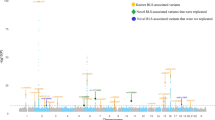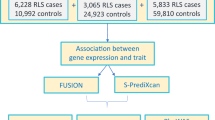Abstract
Restless legs syndrome (RLS) is a highly familial trait with heritability estimates of about 50%. It is a polygenetic disorder in which a number of variants contribute to the phenotype. Linkage studies in families with RLS revealed several loci but have not yet led to the identification of disease-causing sequence variants. Phenocopies, nonpenetrance, and possible intrafamilial heterogeneity make it difficult to define the exact candidate region. Genome-wide association studies identified variants within intronic or intergenic regions of MEIS1, BTBD9, and MAP2K5/LBOXCOR1. Carriers of one risk allele had a 50% increased risk of developing RLS. MEIS1 and LBXCOR1 are developmental factors and raise new pathophysiologic questions for RLS. These variants have weak and moderate effects and increase the risk of developing RLS. It is still possible that strong effects explain the occurrence of RLS in families. Therefore, linkage and association studies should be used congruently to dissect the complete genetic architecture of RLS.
Similar content being viewed by others
References and Recommended Reading
Berger K, Luedemann J, Trenkwalder C, et al.: Sex and the risk of restless legs syndrome in the general population. Arch Intern Med 2004, 164:196–202.
Phillips B, Young T, Finn L, et al.: Epidemiology of restless legs symptoms in adults. Arch Intern Med 2000, 160:2137–2141.
Walters AS, and the International Restless Legs Syndrome Study Group: Toward a better definition of the restless legs syndrome. Mov Disord 1995, 10:634–642.
Allen RP, Picchietti D, Hening WA, et al.; Restless Legs Syndrome Diagnosis and Epidemiology Workshop at the National Institutes of Health, International Restless Legs Syndrome Study Group: Restless legs syndrome: diagnostic criteria, special considerations, and epidemiology. A report from the Restless Legs Syndrome Diagnosis and Epidemiology Workshop at the National Institutes of Health. Sleep Med 2003, 4:101–119.
Montplaisir J, Boucher S, Poirier G, et al.: Clinical, polysomnographic, and genetic characteristics of restless legs syndrome: a study of 133 patients diagnosed with new standard criteria. Mov Disord 1997, 12:61–65.
Allen RP, Walters AS, Montplaisir J, et al.: Restless legs syndrome prevalence and impact: REST general population study. Arch Intern Med 2005, 165:1286–1292.
García-Borreguero D, Allen RP, Kohnen R, et al.; International Restless Legs Syndrome Study Group: Diagnostic standards for dopaminergic augmentation of restless legs syndrome: report from a World Association of Sleep Medicine-International Restless Legs Syndrome Study Group consensus conference at the Max Planck Institute. Sleep Med 2007, 8:520–530.
Ondo W, Jankovic J: Restless legs syndrome: clinicoetiologic correlates. Neurology 1996, 47:1435–1441.
Winkelmann J, Wetter TC, Collado-Seidel V, et al.: Clinical characteristics and frequency of the hereditary restless legs syndrome in a population of 300 patients. Sleep 2000, 23:597–602.
Trenkwalder C, Paulus W, Walters AS: The restless legs syndrome. Lancet Neurol 2005, 4:465–475.
Ondo WG, Vuong KD, Wang Q: Restless legs syndrome in monozygotic twins: clinical correlates. Neurology 2000, 55:1404–1406.
Desai AV, Cherkas LF, Spector TD, Williams AJ: Genetic influences in self-reported symptoms of obstructive sleep apnoea and restless legs: a twin study. Twin Res 2004, 7:589–595.
Xiong L, Jang K, Montplaisir J, et al.: Canadian restless legs syndrome twin study. Neurology 2007, 68:1631–1633.
Allen RP, Earley CJ: Defining the phenotype of the restless legs syndrome (RLS) using age-of-symptom-onset. Sleep Med 2000, 1:11–19.
Walters AS, Picchietti D, Hening W, Lazzarini A: Variable expressivity in familial restless legs syndrome. Arch Neurol 1990, 47:1219–1220.
Trenkwalder C, Seidel VC, Gasser T, Oertel WH: Clinical symptoms and possible anticipation in a large kindred of familial restless legs syndrome. Mov Disord 1996, 11:389–394.
Montplaisir J, Godbout R, Boghen D, et al.: Familial restless legs with periodic movements in sleep: electrophysiologic, biochemical, and pharmacologic study. Neurology 1985, 35:130–134.
Winkelmann J, Muller-Myhsok B, Wittchen HU, et al.: Complex segregation analysis of restless legs syndrome provides evidence for an autosomal dominant mode of inheritance in early age at onset families. Ann Neurol 2002, 52:297–302.
Chen S, Ondo WG, Rao S, et al.: Genomewide linkage scan identifies a novel susceptibility locus for restless legs syndrome on chromosome 9p. Am J Hum Genet 2004, 74:876–885.
Mathias RA, Hening W, Washburn M, et al.: Segregation analysis of restless legs syndrome: possible evidence for a major gene in a family study using blinded diagnoses. Hum Hered 2006, 62:157–164.
Desautels A, Turecki G, Montplaisir J, et al.: Identification of a major susceptibility locus for restless legs syndrome on chromosome 12q. Am J Hum Genet 2001, 69:1266–1270.
Desautels A, Turecki G, Montplaisir J, et al.: Restless legs syndrome: confirmation of linkage to chromosome 12q, genetic heterogeneity, and evidence of complexity. Arch Neurol 2005, 62:591–596.
Hicks AA, Rye DB, Kristjansson K, et al.: Population/based confirmation of the 12q RLS locus in Iceland [abstract]. Mov Disord 2005, 20:P117.
Winkelmann J, Lichtner P, Putz B, et al.: Evidence for further genetic locus heterogeneity and confirmation of RLS-1 in restless legs syndrome. Mov Disord 2006, 21:28–33.
Bonati MT, Ferrini-Strambi L, Aridon P, et al.: Autosomal dominant restless legs syndrome maps on chromosome 14q. Brain 2003, 126:1485–1492.
Levchenko A, Montplaisir JY, Dube MP, et al.: The 14q restless legs syndrome locus in the French Canadian population. Ann Neurol 2004, 55:887–891.
Liebetanz KM, Winkelmann J, Trenkwalder C, et al.: RLS3: fine-mapping of an autosomal dominant locus in a family with intrafamilial heterogeneity. Neurology 2006, 67:320–321.
Lohmann-Hedrich K, Neumann A, Kleensang A, et al.: Evidence for linkage of restless legs syndrome to chromosome 9p: are there two distinct loci? Neurology 2008, 70:686–694.
Winkelmann J, Muller-Myhsok B: Genetics of restless legs syndrome: a burning urge to move [editorial]. Neurology 2008, 70:664–665.
Pichler I, Marroni F, Volpato CB, et al.: Linkage analysis identifies a novel locus for restless legs syndrome on chromosome 2q in a South Tyrolean population isolate. Am J Hum Genet 2006, 79:716–723.
Levchenko A, Provost S, Montplaisir JY, et al.: A novel autosomal dominant restless legs syndrome locus maps to chromosome 20p13. Neurology 2006, 67:900–901.
Kemlink D, Plazzi G, Vetrugno R, et al.: Suggestive evidence for linkage for restless legs syndrome on chromosome 19p13. Neurogenetics 2008 Jan 10 (Epub ahead of print).
Winkelmann J, Lichtner P, Kemlink D, et al.: New loci for restless legs syndrome map to chromosome 4q and 17p [abstract]. Mov Disord 2006, P304.
Kemlink D, Polo O, Montagna P, et al.: Family-based association study of the restless legs syndrome loci 2 and 3 in a European population. Mov Disord 2007, 22:207–212.
Hirschhorn JN, Lohmueller K, Byrne E, Hirschhorn K: A comprehensive review of genetic association studies. Genet Med 2002, 4:45–61.
Desautels A, Turecki G, Montplaisir J, et al.: Dopaminergic neurotransmission and restless legs syndrome: a genetic association analysis. Neurology 2001, 57:1304–1306.
Desautels A, Turecki G, Montplaisir J, et al.: Evidence for a genetic association between monoamine oxidase A and restless legs syndrome. Neurology 2002, 59:215–219.
Winkelmann J, Lichtner P, Schormair B, et al.: Variants in the neuronal nitric oxide synthase (nNOS, NOS1) gene are associated with restless legs syndrome. Mov Disord 2008, 23:350–358.
Lin PI, Vance JM, Pericak-Vance MA, Martin ER: No gene is an island: the flip-flop phenomenon. Am J Hum Genet 2007, 80:531–538.
Winkelmann J, Schormair B, Lichtner P, et al.: Genomewide association study of restless legs syndrome identifies common variants in three genomic regions. Nat Genet 2007, 39:1000–1006.
Stefansson H, Rye DB, Hicks A, et al.: Genetic risk factor for periodic limb movements in sleep. N Engl J Med 2007, 357:639–647.
Capecchi MR: Hox genes and mammalian development. Cold Spring Harb Symp Quant Biol 1997, 62:273–281.
Dasen JS, Tice BC, Brenner-Morton S, Jessell TM: A Hox regulatory network establishes motor neuron pool identity and target-muscle connectivity. Cell 2005, 123:477–491.
Maeda R, Mood K, Jones TL, et al.: Xmeis1, a protooncogene involved in specifying neural crest cell fate in Xenopus embryos. Oncogene 2001, 20:1329–1342.
Gross MK, Dottori M, Goulding M: Lbx1 specifies somatosensory association interneurons in the dorsal spinal cord. Neuron 2002, 34:535–549.
Stogios PJ, Downs GS, Jauhal JJ, et al.: Sequence and structural analysis of BTB domain proteins. Genome Biol 2005, 6:R82.
Lazzarini A, Walters AS, Hickey K, et al.: Studies of penetrance and anticipation in five autosomal-dominant restless legs syndrome pedigrees. Mov Disord 1999, 14:111–116.
Trenkwalder C, Collado-Seidel V, Gasser T, Oertel WH: Clinical symptoms and possible anticipation in a large kindred of familial restless legs syndrome. Mov Disord 1997, 11:389–394.
Schols L, Haan J, Riess O, et al.: Sleep disturbance in spinocerebellar ataxias—is the SCA3 mutation a cause of restless legs syndrome? Neurology 1998, 51:1603–1607.
Abele M, Bürk K, Laccone F, et al.: Restless legs syndrome in spinocerebellar ataxia types 1, 2 and 3. J Neurol 2001, 248:311–314.
Reimold M, Globas C, Gleichmann M, et al.: Spinocerebellar ataxia type 1, 2, and 3 and restless legs syndrome: striatal dopamine D2 receptor status investigated by [11C]raclopride positron emission tomography. Mov Disord 2006, 21:1667–1673.
Van Aften J, Sinke RJ, Twats MJ, et al.: Intermediate CAG repeat lengths (53.54) for MJD/SCA3 are accociated with an abnormal phenotype. Ann Neurol 2001, 49:805–808.
Desautels A, Turecki G, Montplaisir J, et al.: Analysis of CAG repeat expansions in restless legs syndrome. Sleep 2003, 26:1055–1057.
Adel S, Djarmati A, Kabakci K, et al.: Co-occurrence of restless legs syndrome and Parkin mutations in two families. Mov Disord 2006, 21:258–263.
Author information
Authors and Affiliations
Corresponding author
Rights and permissions
About this article
Cite this article
Winkelmann, J. Genetics of restless legs syndrome. Curr Neurol Neurosci Rep 8, 211–216 (2008). https://doi.org/10.1007/s11910-008-0033-y
Published:
Issue Date:
DOI: https://doi.org/10.1007/s11910-008-0033-y




